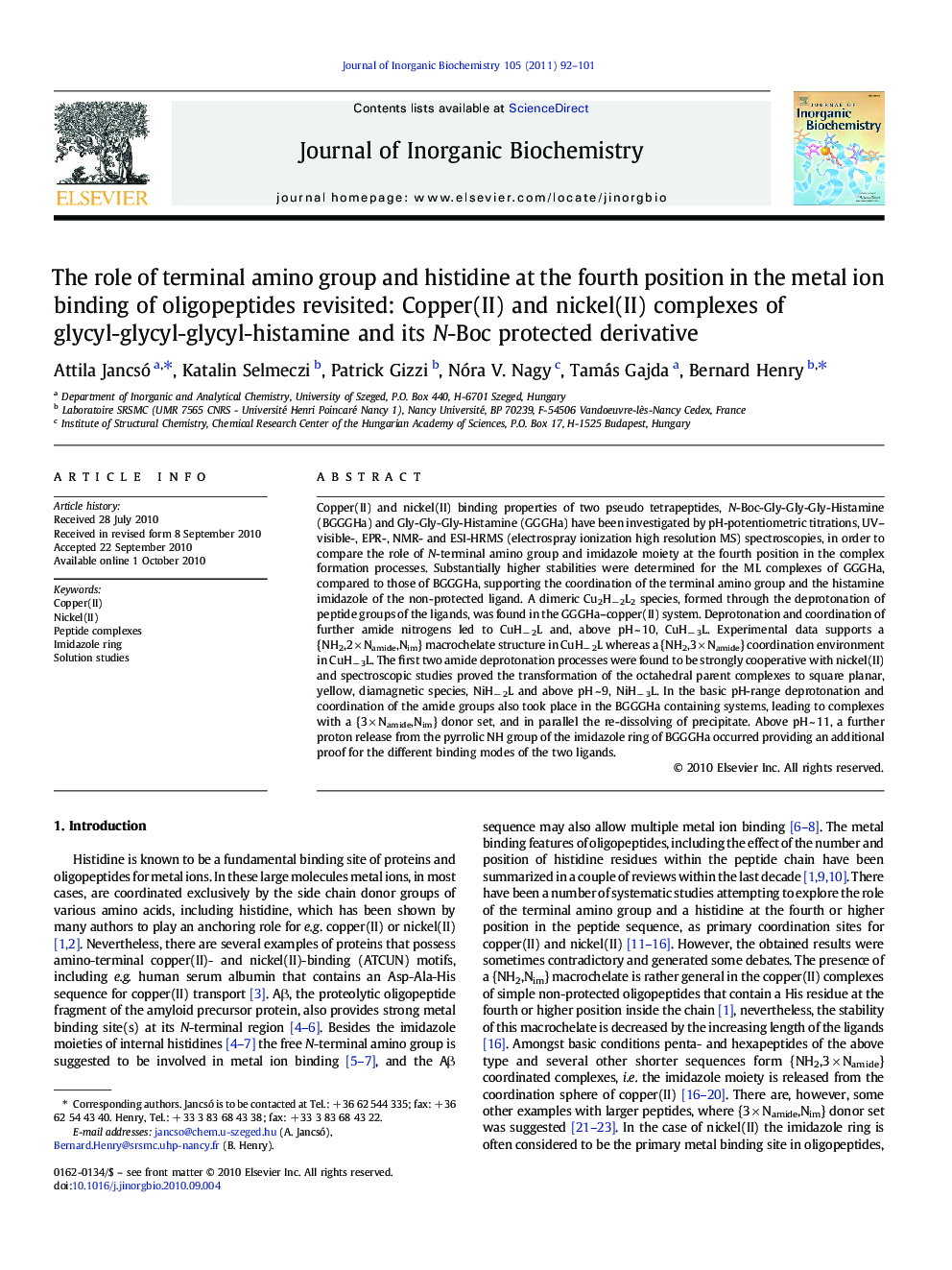| کد مقاله | کد نشریه | سال انتشار | مقاله انگلیسی | نسخه تمام متن |
|---|---|---|---|---|
| 1316331 | 976448 | 2011 | 10 صفحه PDF | دانلود رایگان |

Copper(II) and nickel(II) binding properties of two pseudo tetrapeptides, N-Boc-Gly-Gly-Gly-Histamine (BGGGHa) and Gly-Gly-Gly-Histamine (GGGHa) have been investigated by pH-potentiometric titrations, UV–visible-, EPR-, NMR- and ESI-HRMS (electrospray ionization high resolution MS) spectroscopies, in order to compare the role of N-terminal amino group and imidazole moiety at the fourth position in the complex formation processes. Substantially higher stabilities were determined for the ML complexes of GGGHa, compared to those of BGGGHa, supporting the coordination of the terminal amino group and the histamine imidazole of the non-protected ligand. A dimeric Cu2H− 2L2 species, formed through the deprotonation of peptide groups of the ligands, was found in the GGGHa–copper(II) system. Deprotonation and coordination of further amide nitrogens led to CuH− 2L and, above pH ~ 10, CuH− 3L. Experimental data supports a {NH2,2 × Namide,Nim} macrochelate structure in CuH− 2L whereas a {NH2,3 × Namide} coordination environment in CuH− 3L. The first two amide deprotonation processes were found to be strongly cooperative with nickel(II) and spectroscopic studies proved the transformation of the octahedral parent complexes to square planar, yellow, diamagnetic species, NiH− 2L and above pH ~ 9, NiH− 3L. In the basic pH-range deprotonation and coordination of the amide groups also took place in the BGGGHa containing systems, leading to complexes with a {3 × Namide,Nim} donor set, and in parallel the re-dissolving of precipitate. Above pH ~ 11, a further proton release from the pyrrolic NH group of the imidazole ring of BGGGHa occurred providing an additional proof for the different binding modes of the two ligands.
Graphical AbstractInvestigation of the copper(II) and nickel(II) binding of two pseudo tetrapeptides, N-Boc-Gly-Gly-Gly-Histamine (BGGGHa) and Gly-Gly-Gly-Histamine (GGGHa) allowed to show the dominancy of the terminal amino group in anchoring the metal ions amongst basic conditions.Figure optionsDownload as PowerPoint slideResearch Highlights
► Gly-Gly-Gly-Histamine (GGGHa) forms macrochelated species with Cu2+ and Ni2+ at pH 7.
► NMR proves an equilibrium between two diamagnetic Ni2+ complexes of GGGHa above pH 8.
► One of them has {NH2,2 × Namide,Nim} the other {NH2,3 × Namide} donor set around the Ni2+.
► The N-protected Boc-GGGHa binds metal ions with a {3 × Namide,Nim} mode at high pH.
► The terminal amino group of His4 peptides anchors Cu2+ and Ni2+ at basic conditions.
Journal: Journal of Inorganic Biochemistry - Volume 105, Issue 1, January 2011, Pages 92–101